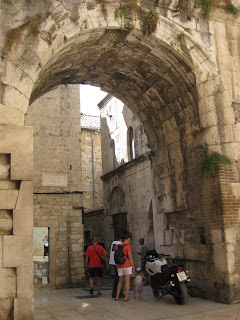Like most places along this Adriatic coast,
In about AD300, an enormous, fortified palace was constructed for the Roman Emperor, Diocletian, as a country villa and garrison. The town of 
Many relics of this era are still standing, including churches, museums and aquaducts.

The city cathedral is little altered from its original condition, as are large parts of the palace. At each of the four corners, a massive stone tower still stands, with narrow slits in the battlements for shooting weapons (of whatever kind) at the enemies outside.
The palace and its battlements gave refuge from many a ransacking over the centuries. After Diocletian’s death, the palace was occupied by the exiles of Salona, fleeing from the Avars and Slavs. Later
This constant invasion, killing, exiling, conquering and claiming is something we find hard to comprehend these days. The history of the whole area is quite cruel and bloody. It seems like everyone else was forever trying to take someone else’s land (and lives) away.
We took a tour of the catacombs and sub-structure of the Diocletian's palace. Here, the Romans kept their slaves and persecuted Christians. Later the vast caverns were used for rubbish and sewage disposal, but restoration and preservation programs have cleaned that all out, for present day benefit.
Today, tourists wander through by the droves and stall-holders sell souvenirs. The vaulted ceilings have incredibly intricate, circular patterns of stone-work laid in their domes. Beautiful stone carvings adorn the odd alcove, begging the question “why?"
Why all the statues and gargoyles and decorative finishes to otherwise purely functional, often besieged constructions?
It was the same question we pondered with regard to all the really old buildings, some of which took hundreds of men hundreds of years to build. How did they maintain that continuity of purpose?
Between the palace and the sea is another common feature of these towns – a wonderful, white-tiled expanse of no-vehicle, people-space, where visitors and locals alike can promenade idly.
Here, there are cafes and bars, street-food stalls selling hot corn cobs, pancakes with nutella, ice-creams, plus other souvenir stands. Small children are given rides in straw baskets.

It is a relaxed, holiday atmosphere. In the evening, live music and folk-dancing are laid on for our free entertainment and we can choose either to go ashore amongst the throng, or listen from our nearby anchorage.
The harbour is a busy place, being a central hub for the many vehicular ferries which service the nearby islands, as well as the huge cruise ships which come from all over the Med.

Sandy beaches are a rarity in Croatia, but not far away we found one – as did everyone else!



No comments:
Post a Comment